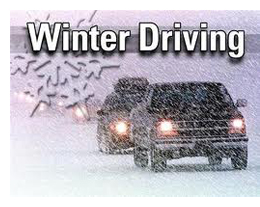
Will your car go in freezing rain and snow?
Ada City-County Emergency Management (ACCEM)
‘Tis the season to be out shopping, going skiing or traveling to visit family and friends. It also is a time of year when many will find themselves going somewhere in their motor vehicle when weather and road conditions may not be the best.
The most common natural hazard in Ada County is extreme weather, and part of being prepared is making sure your vehicle is ready for winter. Getting stuck out in the weather due to a mechanical failure could lead to exposure-related injuries or illness. Take the following steps to minimize your risk:

 Too cold to crank?
Too cold to crank?
The colder it gets, the less efficient a vehicle battery operates. If a battery is weak, it may fail in cold weather. Have the battery tested to be sure it’s in good working order. It may need to be recharged or replaced. The following care tips will help maintain the battery.
* Keep posts and cables clean and clear of corrosion. Make sure cables are connected tightly to posts.
* If possible, check fluid levels inside the battery and keep them at the proper levels.
Newer vehicles have a growing number of electrical and electronic safety, convenience and entertainment systems. Power consumption in those cars can be as much as three times greater than that used by cars built 20 years ago. This usage makes monitoring and maintaining the battery an even greater priority.
Check it, before you depend on it
There are basic maintenance checks that should be made on a vehicle periodically. Below are those that should be made before depending on your vehicle for safe travel during the winter.
-
Engine oil: Check for proper level, oil condition and type. Refer to owner’s manual to see if a different weight oil is recommended for cold weather.
-
Windshield wipers/fluid: Make sure wipers are in good shape and the washer fluid reservoir is filled to the proper level.
-
Use no-freeze wiper fluid and carry spare fluid in the vehicle.
-
Heating/cooling system: Check radiator hoses for bulges, cracks or leaks. Add anti-freeze mixture if it’s low or have the system flushed and refilled if the anti-freeze is discolored. Some vehicles require a flush of the system every other year as part of the normal maintenance.
-
Heater/defroster: Test these systems to ensure they are working properly. Driving in a winter storm is not the time to find out they do not work.
-
Lights: Check all headlights, taillights, brake lights, turn signals, emergency flashers and back-up lights. Vehicle lights are critical in low visibility; replace any non-functioning bulbs.
-
Tires: Winter driving requires good traction. Inspect vehicle tires for uneven wear, cracking and tread depth. If the tire tread is 2/32-inches (exposed wear bars) or less the tires should be replaced.
All-season tires should work in areas with light to moderate snow. Travel in areas of heavy snow may require studded snow tires or chains. Check tire pressure frequently during cold weather. Tire pressure can decrease one to two pounds per square inch for every 10-degree drop in outside temperature. Under-inflated tires can be dangerous and damage the tire.
Keep these items in your vehicle as a winter driving kit:
-
Ice Scraper/snow brush
-
General First Aid kit
-
Toolkit/jumper cables
-
Flashlight/batteries
-
Blanket/sleeping bag
-
Cell phone/car charger
-
Non-clumping kitty litter (for traction)
-
Flares/reflective triangles
-
Shovel
-
Non-perishable food/drinking water
Published 12-9-2011